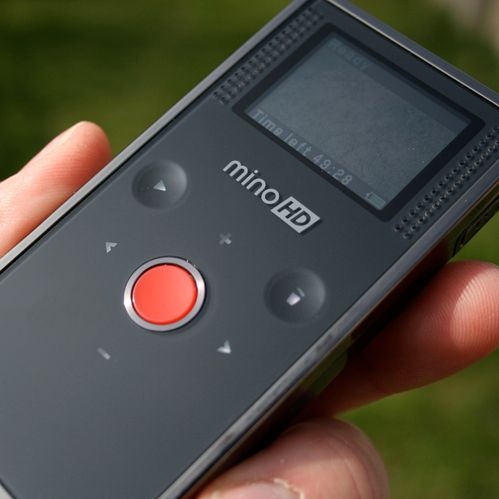With pocket camcorders upping the ante at every step, we'd barely seen the launch of the Flip Mino in the UK when the Mino HD started circulating gadget sites. We've liked the simplicity of the Flip in the past, but can it cut it in the high-definition world?
Our quick take
With gadgets moving on so fast, you can't help but notice that the Flip Mino HD doesn't offer as much as you'll get on competitor models - you'll have to make do with less memory, a smaller screen and no options. On the plus side is price, coming in at a substantial £50 less than the Creative Vado (online discounts aside).
Viewing your HD video is also not as simple as we would like. With no HDMI and the on-board software uploading regular resolution, you might miss out altogether. To play it back, you have to play the files directly on your PC (which for some might be the only requirement), or move the files off to somewhere else. We feel this takes a bite out of the simple approach that these pocket camcorders need.
So the Flip Mino HD wins points for its size and price, but loses them for making the viewing of those files a fiddly experience and keeping that small screen that now seems impractical.
Overall we can't help but feel that Flip is slowly losing its way in a market it practically invented, which is a great shame.

Flip Mino HD camcorder - 3.0 / 5
| FOR | AGAINST |
|---|---|
|
|
In terms of design, the only thing that differentiates this from the regular Flip Mino is the addition of the HD moniker on the back. That's not really a good place to start, because we criticised the Mino for retaining the small screen of the original Flip, and you still have it here. To have changed nothing in a rapidly changing world seems foolhardy.
So you are still faced with that 1.5-inch, 528 x 132 pixel screen, but there is a new problem to deal with: 16:9. As the screen is a 4:3 aspect, you'll find black lines on the top and bottom to give you a 16:9 image on the screen. Considering the screen is tiny, you're left seeing very little of what you are actually filming, or have filmed.
Perhaps you'll say that this doesn't matter because it is a pocket camcorder, but it's a noticeable step behind the competition from Creative, Kodak and now Toshiba.
In terms of control you'll find the power on/off button on one side of the device and the pull catch to release the namesake flip-out USB connector. On the back you'll find a central red record button, with touch controls to deploy the 2x zoom, delete your dodgy videos, as well as playback and skip back and forth through files.
Like the previous incarnation there is an internal battery which charges when connected to a USB socket, with a flashing white LED to signal a connection. The HD recording means you'll now only get 2 hours from the battery, with the 4GB memory giving you 1 hour of HD recording.
For those wondering what brand of HD you get here, it's 1280 x 720 and as said earlier, in a 16:9 aspect, captured a 30fps. The resultant file is an MP4 H.264 video with AAC audio encoding.
Like previous Flips you get a 2.5mm jack on the side so you can hook straight up to your TV. Unfortunately, once again the HD dream doesn't seem to have been realised here as you'll be supplied with a Composite cable. What happened to the HDMI?
On the bottom you'll find a standard tripod screw mount, which is great if you just want to film yourself, although with a flat bottom you can stand it on a table - something that the Creative Vado cannot do - and is useful for video diaries and the like.
You'll find the software on the device for both PC and Mac, enabling playback, basic editing and various sharing options, including direct upload to YouTube and MySpace. Unfortunately if you want to share the HD footage, you'll have to upload directly to YouTube as the uploader will only send over HQ video - something to watch out for.
But the real decider here will be in the quality of the video captured. Fortunately the end result is solid. We've been impressed with the Flip's abilities in the past and you get the same good performance here. Viewing in HD the colours are solid, there is plenty of detail in video and skin tones are natural.
We also found that the Mino HD coped pretty well with changes in lighting conditions, and is quick to counter bright spots. Low light performance is also good, without too much noise - again a natural look and feel to the results.
As with all small camcorders you'll find that movement does not bode well for the Mino HD as images bounce around all over the place - the best results really are from siting the device in a static location.
To recap
Overall we can't help but feel that Flip is slowly losing its way in a market it practically invented, which is a great shame
